#the dialogue icon was made in illustrator (still not a fan especially when it comes to joining shapes THAT SHIT SUCKS!)
Text


made these on a whim
#meli#splatoon#as it turns out. clip studio paint has a default brush that looks like whatever's used for the mem viewer art.#the dialogue icon was made in illustrator (still not a fan especially when it comes to joining shapes THAT SHIT SUCKS!)
6 notes
·
View notes
Photo
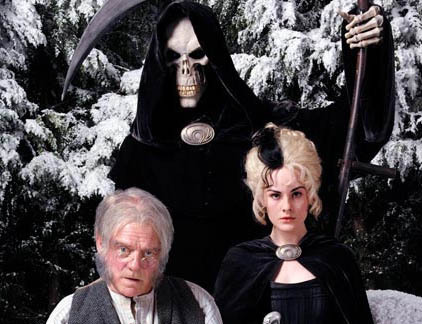
Alright it’s a bit past Hogswatch but we’re going to talk about the Sky One Hogfather adaptation, ‘kay?
In the wake of the premiere of BBC America’s The Watch it’s good to remember that Sky One did adaptations of Sir Terry Pratchett’s Discworld books and that they actually cared about the original content. The Hogfather is a two-part miniseries that is a faithful retelling of the book. Some might say too faithful--there are scenes which add very little to the Plot, which are in the movie/miniseries because they’re in the book, when specific bits that give them context are not. I imagine if you haven’t read the book, it’s a bit hard to follow. Like, “Why is there a little rodent Grim Reaper?”
Still, it’s made with such care and attention to detail that if you ARE a fan of the book you’re sure to love this movie. No, it doesn’t have the budget of a big Hollywood movie, and it shows at times. But I think it also shows that a big Hollywood budget isn’t always the best way to adapt a book, as I imagine we’d have gotten something more like The Watch if this had been made by a large studio.
So the story goes like this, if you don’t know: in the Discworld, a satire of fantasy worlds, there are beings called the Auditors of Reality and they hire an Assassin to kill the Discworld equivalent of Santa Claus (a being called the Hogfather) in their plan to eradicate humanity because they’re jerks like that. Death, the Grim Reaper, being somewhat fond of humanity, takes it upon himself to fill in for the Hogfather while he’s indisposed. Death’s granddaughter, Susan-- currently working as a governess in Discworld’s most populous city Ankh-Morpork--gets drawn into the Plot and takes it upon herself to go and save Christma--I mean Hogswatch.
What follows is a bright satire of basically all the Christmas specials, stories, and cliches, as well as a surprisingly deep reflection on the nature and purpose of human belief in the supernatural, especially when it comes to children’s stories.
This miniseries is pretty long. On DVD it’s split into two parts, each an hour and a half, which makes it more manageable for me to sit through. But just be aware if you decide to watch it that if you want to try it all in one go, you’re going to be there for about three hours, at least.
Some quick highlights from the cast:
Michelle Dockery, pre-Downtown Abbey, plays Susan, who is more or less our main character. And I’m not going to lie to you: not all of her acting in this miniseries is on point. I get that she’s going for someone who is very emotionally detached, reacting to the weirdness of the supernatural world with exasperation and cynicism rather than wonder or terror or awe. But having seen this movie a bajillion times there are lines that she delivers with no emotion at all. Not stoically, but like she really doesn’t care what she’s saying, and that kind of bothers me.
Marc Warren plays Jonathan Teatime. He apparently modeled his performance off of Johnny Deep’s Willy Wonka, which is an interesting choice but one that makes sense. He hits all of the creepy vibes and he does a pretty good job. He’s not how I imagined Teatime, but he does a good interpretation that fits with the character and makes him a good villain.
[Also because of this miniseries apparently an alarming number of fans ship Susan and Teatime? No I don’t get it.]
The late Ian Richardson plays Death. Death is Awesome. I don’t know if it’s him in the suit, but regardless, Death’s remarkably expressive considering he’s a skeleton in a robe (and then a Santa costume). Whoever is in the suit, whether it’s Richardson or someone else, should be given a lot of credit, as well as Richardson for imbuing his voice with a personality that feels if not straight out of Terry Pratchett’s work, very close to it indeed. And no, I suppose he doesn’t look like a realistic skeleton, but he still looks really good on screen, like straight out of one of Kidby’s illustrations for the series.
Longtime Discworld fanboy David Jason plays Albert, Death’s butler, who is desperately trying to smoke and can never get to finish rolling his cigarette. He’s one of the best parts of the film, cynically trying to get his boss to be a jolly sentimental icon while maybe (probably) being drunk off his butt.
Joss Ackland is Mustrum Ridcully, the Archchancellor of Unseen University. Head of the wizards, more or less. He is both the sane man among the wizards (if you don’t count Ed Coleman’s Ponder Stibbons, who is actually sane and very good at his role too), and very ridiculous, though I suppose that might in part be the other wizards are pretty silly. He’s a joy to watch too.
And there are other cast members who all look like they’re having fun in this miniseries, but most notably: Terry Pratchett. All of these Sky One adaptations have Terry Pratchett in them at one point or another, and always delivering the final line of dialogue in the film.
If you’re a Terry Pratchett fan, or are curious about Terry Pratchett’s work, I imagine you’ll probably like this miniseries. If you’re not, I can’t promise you’ll have a good time, but it’s an adaptation made with unwavering love for the source material, and in today’s world that’s sometimes pretty difficult to come by.
31 notes
·
View notes
Text
Review : Bill & Ted Face the Music (2020)
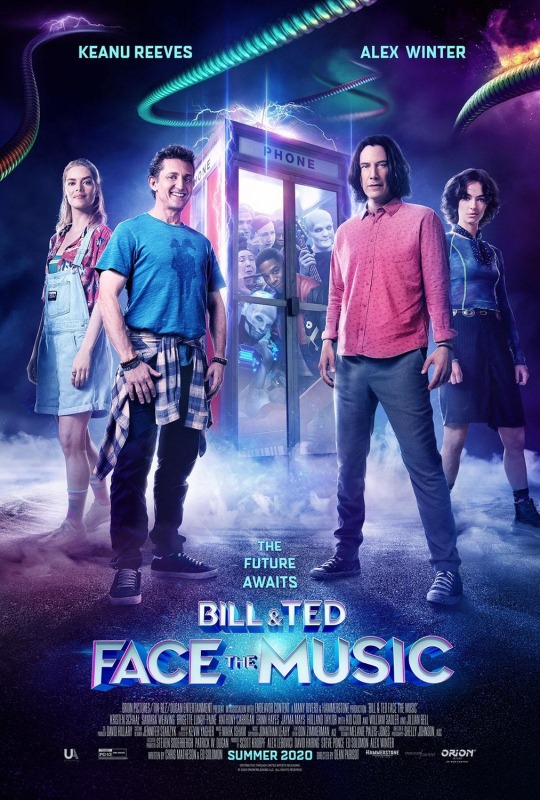
As a child of the 1980′s, there are certain cultural things that I am almost obligated to be a fan of, and somewhere high on that list are the Bill & Ted movies. As a fan of the first one, I was over the moon when a sequel was released two years later, but if someone would have told me then that, nearly three decades later, the pair of films would become a trilogy, I would have laughed long and hard. This sentiment only grew stronger with each passing year that Keanu Reeves became an icon, while Alex Winter (unfortunately) was veering towards the realms of an afterthought. Then, in 2019, the announcement of Bill & Ted Face the Music went from rumor to greenlit project, and even with the world shutting down, the film still found its way into the hands of moviegoers, answering many of our ‘what if?’ questions about the franchise.
In the year 2020, Bill S. Preston Esquire (Alex Winter) and Theodore ‘Ted’ Logan (Keanu Reeves) are still struggling with the their prophesized task of uniting the world through a Wyld Stallyns song. Unbeknownst to the duo, their inability to fulfill the prophecy is causing damage in the space time continuum, specifically in the form of a collapse that is displacing people and objects randomly throughout time and space. At the behest of The Great Leader (Holland Taylor), Kelly (Kristen Schaal), the daughter of Rufus (the late George Carlin), travels back in time to bring Bill & Ted to The Great Leader, who informs them that they have until 7:17 PM that day to write the song before the space time continuum fully collapses. Unsure of themselves, and scared at the possibilities of losing the Princesses (Erinn Hayes and Jayma Mays), the duo begins travelling throughout their lives in hopes of finding a version of themselves to give them the universe-saving song. Meanwhile, Bill & Ted’s daughters, Thea (Samara Weaving) and Billie (Brigette Lundy-Paine), secure Kelly’s time traveling device in hopes of securing the most righteous band they can, but as the legend-filled roster prepares to assist Bill & Ted, all parties find themselves not only rushing to beat the clock, but to avoid Dennis Caleb McCoy (Anthony Carrigan), an android sent by The Great Leader to kill Bill & Ted prior to their failure, should they fail.
For a film that could have easily sat back and played the nostalgia hand, Bill & Ted Face the Music is a surprisingly insightful look into the process of self-fulfillment, unconditional love and finding ways to support your family while achieving your hopes and dreams. Seeing the Bill & Ted characters in a grown-up capacity, while strange at first, ultimately opens the door for viewer self-reflection as well, especially for those that grew up fans of the original two movies. While there are echoes of the previous two movies (journeys through time to collect important figures, a pit-stop in hell), these moments are auxiliary to the main focus, which finds Bill & Ted literally attempting to take command of their loves and lives by a symbolic (and literal) examination of all aspects of both. While the duo are quite literally ‘facing the music’ of fulfilling a universal destiny, they also find themselves equally ‘facing the music’ of how even the most sincere, openly loving people can still leave those close to them unfulfilled and wanting more, which further illustrates the fact that we’re never too old to rediscover ourselves.
The casting callbacks throughout the film are wonderful, with Missy, Mr. Logan, Deacon, the Grim Reaper, The Great One and even Rufus all making appearances throughout the run of the film without succumbing to the trope of fan service. We are also treated to the original phone booth as well, while simultaneously seeing the improved technology that occupants of the future now use in place of the phone booth, similar to how many of us have evolved from using phone booths and house phones in our modern world. Putting the educational journey into the hands of Thea and Billie also works beautifully, as this duo takes a journey down the halls of musical prowess rather than historical figures. Even the joke of Bill & Ted’s musical ability has evolved, with the duo now brave enough to pick up a litany of standard and obscure instruments, covering a wider base of genres than the pure rock we knew them for, and somehow still finding themselves unable to fulfill their assigned destiny.
Production-wise, all of the expected beats are hit, and narratively, the chaos of time travel takes a much bigger placement in the driver’s seat than in previous films. The real joy comes from seeing Bill & Ted interact with the many different versions of themselves that they encounter, be it run-down alcoholic versions, super-buff prison inmate versions, or even deathbed Bill & Ted, all of whom are given distinct personalities while still fitting into the classic Bill & Ted mold. Being able to pull so many previous members of the cast back into the story definitely helps as well, as their years of working with one another not only jumps off the screen, but gives the new characters a safe foundation to work with as they integrate themselves into the story.
Despite their previously mentioned day and night career trajectories, seeing Alex Winter and Keanu Reeves working together again is a joy to behold, as their undeniable chemistry is stronger than ever, and any sense of an ego is not visible to the viewer. For as talented and accomplished as Samara Weaving and Brigette Lundy-Paine are, it’s fun to see them fall into a sort of female Beavis and Butthead situation, where they can let their guard down and just go along for the incredibly silly ride. Kristen Schaal is hilarious as always, finding ways to milk her comedic moments without upstaging the stars or hamming things up. William Sadler also falls right back into his old ways as the Grim Reaper, including my favorite sequence of all where he shows how upset he is for being sued after trying to take the Wyld Stallyns name away from Bill & Ted. Erinn Hayes and Jayma Mays step out a bit more as the Princesses, even getting a chance to play older versions of themselves at times (albeit it dialogue-free). Amy Stoch, Hal London Jr. and Beck Bennett also sit right back into their respective characters, while Holland Taylor steps in wonderfully to replace the large void left in George Carlin’s absence. DazMann Still, Jeremiah Craft, Daniel Dorr and Sharon Gee all meet the task of playing their respective legendary musician roles, while Kid Cudi finds the humor in the task of cameoing as himself. Appearances by Jillian Bell, Dave Grohl, Anthony Carrigan, Patty Anne Miller and Win Butler round things out, with a few fun faces popping up in the credits as well.
If you’ve ever had an inkling of enjoyment for any of the movies in the Bill & Ted franchise, then Bill & Ted Face the Music was made for you. It may not win any awards this trophy season, and it certainly won’t reinvent the way that we look at movies, but it will entertain you, and it may even remind you of a simpler, more innocent time that we enjoyed as film fans.
#DOOMonFILM#ChiefDoomsday#Bill&TedFaceTheMusic#DeanParisot#KeanuReeves#AlexWinter#KristenSchaal#SamaraWeaving#BrigetteLundy-Paine#WilliamSadler#AnthonyCarrigan#ErinnHayes#JaymaMays#HalLandonJr#BeckBennett#KidCudi#AmyStoch#HollandTaylor#JillianBell#WinButler#DazMannStill#JeremiahCraft#DanielDorr#SharonGee#PattyAnneMiller#GeorgeCarlin#KellyCarlin#DaveGrohl#WeirdAlYankovic#GuillermoRodriguez
4 notes
·
View notes
Text
The list of my 20 favorite movies, vol.2 (2019-2020)
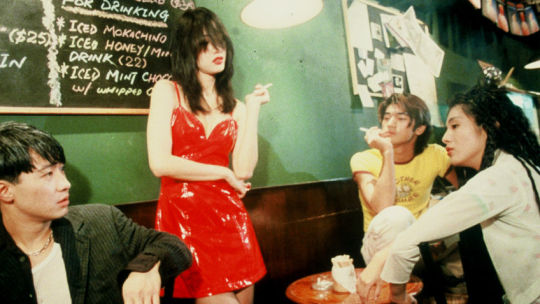
Back in 2018, I decided to start this experiment choosing my 20 favorite films, as it is at this particular moment. Used to sound a little silly to me first, yet I realized later this experiment has a merit if you do it once in a year. It’s just like a diary documenting your thoughts, ideas and sources of inspiration at some point. These things may change fast and they strongly affect person’s predilections, whether we talk about films, books or songs. It is simply fascinating to observe your personal development or changes based on the conclusions you can draw from your own favorite films. This year I was supposed to make this list 6 months ago but I just didn’t really feel like to. Now it’s time to get back to this fascinating experiment so here is its implication!
20. Spring in a Small Town (小城之春)– 1948, Fei Mu. China

Released one year before Communists’ takeover of China, Spring in a Small Town remains the most well-known film unveiling China in the period we all know very little about. The plot concerns a story of a married couple and their bitter days they live as the symbolic representation of the wreckage left by the World War. The story is delicate, psychological, poetic and beautiful. It is narrated in a very intelligent manner highlighting the exceptional talents of both Fei Mu and actors, especially Wei Wei who is still alive, aged 97 as of the end of 2019. Spring in a Small Town has been called The Greatest Chinese Movie ever made by Hong Kong Film Awards Association.
19. Masculin, Feminin – 1966, Jean-Luc Godard. France

I’ve seen quite a few films of Godard and I find most of them outstanding. However, his most politically and socially charged work Masculin, Feminin retains a special place in my films knowledge base. I’m still impressed with this combination of those monologues delivered by young Parisians and bizarre scenes from the rebellious lives of youngsters. The film features wonderful tunes turning into a great addition to the illustration of the political and social tension in France in the 1960s. Masculin, Feminin reminds that France is the most rebellious nation in the world, in terms of fighting for liberal values and equality. Moreover, the feature of Godard gives a great glimpse into several matters of gender situation and problems of France in the 1960s.
18. The Rules of Game (La Règle du Jeu) – 1939. Jean Renoir. France

One of the greatest examples of satirical films ever produced, The Rules of Game by Renoir strikes with the glorious cast, quality humour and excellent depiction of the French wealthy class decay before the devastating events of the war. An outstanding example of sophisticated director’s work and brilliant story, this film is also perfectly crafted and lensed, cinematography wise. The feature was considered controversy 80 years back upon release and almost felt into obscurity despite being the most expensive French film till that date, in order to re-gain attention and acclaim later becoming a symbol of French cinema greatness.
17. Spring, Summer, Fall, Winter… and Spring (봄 여름 가을 겨울 그리고 봄) – 2003. Kim Ki-duk. South Korea

The only Korean film I’m going to list in my 20 favorite is the most well-known feature of Kim Ki-duk I’ve been admiring or years. A very simple work based on the number of the basic Buddhist symbols and references, it is obviously made to be accessible for the Western viewers. The pace of the film is gentle and calm while the environment strikes with beauty and evocative power. I’m quite a fan of Korean movies, especially when it comes to Lee Chang-dong, though I’m yet to explore most acclaimed Korean directors and their films. Eventually, I’d keep Spring, Summer, Fall, Winter… and Spring as my favorite Korean film this year again.
16. The Straight Story – 1999. David Lynch. USA

It’s been a long time David Lynch remains my favorite director. I absolutely love Blue Velvet, Mulholland Drive, Lost Highway as well as in fact all of his works. The Straight Story however always stood out. Somehow, it feels like David Lynch wanted to show with this feature that he is capable of many different genres, styles and he’s got a strong grasp or traditionally narrated stories. The Straight Story is a bitter, wise and sublime story of an old man looking back at all his life while knowing there is nothing left to expect from the future. The life was long viewed as a vibrant matter, a treasure, an excitement. In his last travel across America, he reminisces about his life in these beautiful shots, having long Hemingway-like dialogues with the curious people he encounters. The scenery is marvelous and the music of Angelo Badalamenti is something you can never forget. No doubt, my favorite film of David Lynch.
15. Stalker (Сталкер) – 1979. Andrei Tarkovsky. USSR

Most of Tarkovsky’s films are so rich in what can be hardly seen or comprehended that I’ve been always asking myself whether I’m ready for such an art experience or not. Stalker, perhaps one of the most complicated films of him (behind Mirror, though), offers numerous layers, means, ideas and features the viewers can delve into. The film is truly intellectual and also extremely beautiful and enchanting. It is also one of the finest examples of vivacious actors’ work. Moreover, the special credit must be given to Tarkovsky’s cinematographers Rerberg and Knyazhinsky. Those iconic long takes with slow camera movement are magnificent.
14. Syndromes and a Century (แสงศตวรรษ) – 2006. Apichatpong Weerasethakul. Thailand
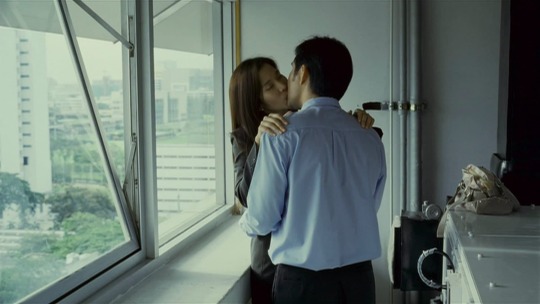
It is said there are some feature-length films, of which the viewers cannot get much unless they watch together with the other films of the same director, as these loosely connected works can be comprehended together. From my point of view, Apichatpong Weerasethakul and his art is the case. I could name several films of him I admire, yet I can’t say I really liked any of them when I watched them first. It takes quite some time to familiarize yourself with his work, in order to understand how you can comprehend it. The yield might be highly awarding for many of those who’s got passion and absolutely fruitless for others. Syndromes and a Century remains my favorite film of the Thai director due to it’s emotionally charged shots and scenes depicting the beauty of humanity, transformations of people and their feelings. Apichatpong Weerasethakul is playing with the subtle material eventually giving space to draw numerous interpretations of his work. It’s tantalizing and entertaining!
13. Paris, Texas – 1984. Wim Wenders. West Germany / USA

The finest combination of road movie with psychological drama resulted in a masterpiece created by the German director Wim Wenders who had shot this film in the United States. The story is very emotional and very intelligent at the same time. Also, it is one of the best works of Harry Dean Stanton who has been famous during his 60-years career as an actor of supporting roles. Being given a lead role here, he really made his character special.
12. Only Lovers Left Alive – 2013. Jim Jarmusch. USA

I’ve already written and said many things about this film as Jim Jarmusch is certainly among my beloved directors, with his enigmatic style. Only Lovers Left Alive is a film basing on a number of references and themes Jarmusch has been fascinated by for years. To understand many hidden things, it is important to see all films of him and try to think in a way he does. Unfortunately, Jarmusch doesn’t make many references quite available to those who don’t know his works well. On the other hand, even those who don’t qualify can still watch this visually striking story and enjoy the beauty of music instruments, locations, shots and aloof characters.
11. Tokyo Story (東京物語) – 1953. Yasujiro Ozu. Japan

According to many of the most acclaimed film critics and directors, Tokyo Story is the greatest Japanese film ever made and maybe of the finest masterpieces ever. The Golden Age of Japanese cinema with the works of Ozu, Mizoguchi, Naruse and other directors was truly marvelous, and Tokyo Story is widely considered to be its acme. The famous tatami shots, slow plot development, simple but very deep story, fantastic play – all these well-known Ozu’s features are present here in abundance. This is a film of an exceptional emotional degree ensuring the full immersion into it. The pace might be slow for many viewers and requires some exposure into Japanese classical cinema. Yet this experience is certainly worth acquiring, as the harmony with Japanese classic films is rewarding and memorable. Nevertheless, this is still not my favorite Ozu’s films, as of 2019/2020.
10. Apocalypse Now – 1979. Francis Coppola. USA
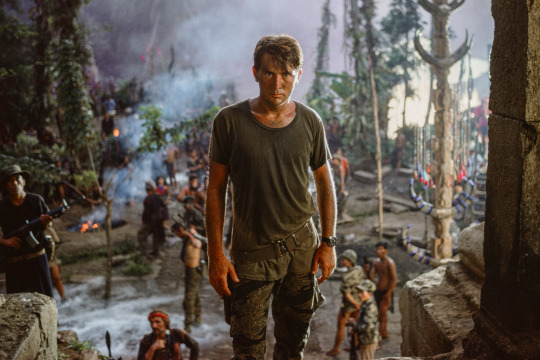
Apocalypse Now is among the greatest American films in my eyes for a personal reason. A few years back, the film had taught me to admire the cinema and provoked my keen interest in it. This epic war-related drama goes far beyond the topics of war depicting a humankind’s journey down the hell. The funnel of dehumanization as I called while writing about this film a couple of years back. Absolutely masterpiece, Apocalypse Now.
9. An Autumn Afternoon (秋刀魚の味) – 1962. Yasujiro Ozu. Japan
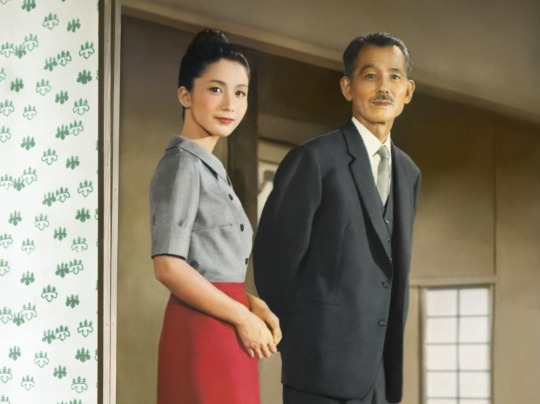
An Autumn Afternoon became a final film of Ozu. Along with his penultimate feature The End of Summer, it turned to be one of the recent treasures I discovered. The plot reminds of Late Spring, the film I named my favorite as of the end 2019. Yet the mood, key motifs and main themes are quite different. These several parallel stories within the same film depict the changing society and strong family bonds between generations. The traditional culture meets changing world showing there is always a room for wisdom, and people’s feelings don’t change in the same way as times and cultural environment do. One of the best casts Ozu ever assembled is another thing contributing to this outstanding film. Chishu Ryu, Shima Iwashita and Mariko Okada are the greatest actors of the Japanese cinema Golden Age making good replacement of Setsuko Hara who was not present here. There is so much to say about this film explaining why I love it better than Tokyo Story for example, yet I expressed it better in my older review.
8. Lost in Translation – 2003. Sofia Coppola. USA
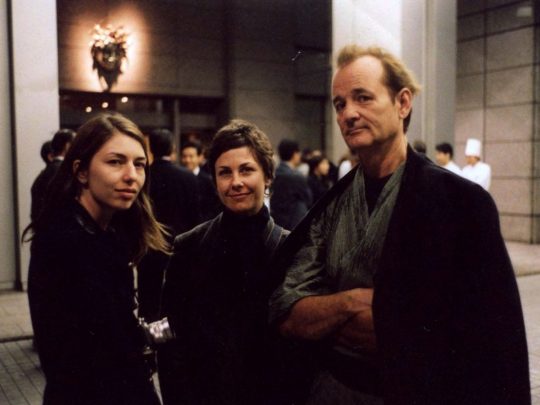
Starting with An Autumn Afternoon, my list of favorite films enters the dimension of emotions. My choice of previous movies was quite understandable in a way of common sense and proper explanations, but the rest would be nothing, but emotions. I’m quite impressed with this myself and this is just why I started considering valuable this experiment of writing a list of favorite films every year. Where would it take me? Saying Lost in Translation is my favorite American film would probably sound crazy! But here we are. How would I get it explained? Emotions. This emotional sublime charge of it is just one of a kind. A perfect style created by Sofia Coppola, a subtle story, breathtaking path and wonderful collision of fun and deep feelings… This is Lost in Translation. And there is always more and more you get and understand while watching it. This choice is romantic, but I’m getting along with that.
7. Days of Being Wild (阿飛正傳)– 1990. Wong Kar-wai. Hong Kong

Time for the first film of Wong Kar-wai to appear in my list! Back in 2019 when I made this list last I was not a big fan of Days of Being Wild. However, I’ve seen it at least 5 times later slowly getting into this world of the wonderful romance, lovesick young people, strange lights and wonderful props and shots. The first collaboration of Wong Kar-wai with Christopher Doyle establishing this duo that would be crafting visual delights in a few other features. A wonderful cast with Leslie Cheung, Karina Lau, Maggie Cheung and Andy Lau in addition to wonderful music… It is slowly getting me, more and more. Yet again, this choice is nothing but my sense of romance in the cinema.
6. The Scent of Green Papaya (Mùi đu đủ xanh) - 1993. Tran Anh Hung. Vietnam / France

This film is shot in Vietnamese and the drama is entirely Vietnamese. However, the director Tran Anh Hung has been living and working in France for most of his life so the movie should be considered French. Nevertheless, I personally take it as the greatest Vietnamese feature film as it had opened Vietnam for me from a new angle. It is an extremely beautiful film the shots of which seem to be inspired by the work of Fellini’s or Tarkovsky’s cinematographers and are also enhanced with vibrant, vivid colors, the striking shine of nature around the characters and warmth of their emotions. A gorgeous story, a glimpse into the world that perhaps never existed, the supreme sophistication of The Scent of Green Papaya had become the last reasons for me to relocate to Vietnam, even though I always the reality of Tran Anh Hung’s film only exists on the screen. Inspiring and breathtaking, a lovely and adorable film!
5. The Assassin (刺客聶隱娘) – 2015. Hou Hsiao-Hsien. Taiwan

One of the prominent directors of the Taiwanese New Wave Hou Hsiao-hsien is a living god of art-house cinema. He had created multiple beautiful slowly paced features of which I’ve seen about 10. Relatively unknown in Asia, he has been highly respected in Europe, especially in the eyes of orientalists. His last film The Assassin has received many accolades such as an Award to the Best Director received by Hou Cannes. The Assassin is an acme of the visual beauty and technical sophistication of cinematography. This film would be very boring for those viewers who are used to the narrative features. Here the plot doesn’t really matter, as the film was made to immerse the viewers into the mood, visual beauty, atmosphere. It comes as a wuxia film, yet many critics call it a deconstruction of wuxia. The protagonist portrayed by Shu Qi gives a detached effect of both character herself and also the whole world around from the traditional way of storytelling. It really takes time to look into this film properly, I didn’t understand if I entirely liked it or not when I watch The Assassin first. I’ve started getting from the 3rd or maybe 4th time. And this is how this film is. My opinion about this film has changed a lot since the moment I wrote my first comments on it. A delight for those who admire visual delicacies, the film of Hou Hsiao-Hsien, in my eyes would probably always remain a standard of beauty I’ve seen on the screen.
4. Yi Yi (一 一) – 2000. Edward Yang. Taiwan

Getting back to the films I select as the ones standing upon the pillars of smart and intelligent stories, I’d call Yi Yi my favorite Taiwanese film ever. The last and the best feature of Edward Yang has three perspectives in its story shifting from the glimpse into one generation of the family into another. This is a story of very simple people’s relations, feelings and emotions showing how the life goes around in a circle. It is almost impossible to find any weak points of this marvelously crafted story of three generations showing so many feelings and problems related to love, middle-age crisis, development of the individuality, childhood, teenagers’ discoveries, the fate of old people. The whole life is here, in Yi Yi. The film makes the viewers ruminate and look into their own lives from a different angle. The story is being told by a wise man who has got good eye observing littlest things in everyday’s life that really matter and make a difference. With little or without action at all, the slow pace of Yi Yi brings genuine emotions to those who watch it. Like I wrote in my review on Yi Yi, it was one of the strongest impressions I have ever had watching a film.
3. In the Mood for Love (花樣年華) – 1999. Wong Kar-wai. Hong Kong

It’s been already told too much about this film in my reviews of Wong Kar-wai’s films I’ve written for my blog, and I want to stay away from iterations. I’d just say that one of the fascinating recent developments about In the Mood of Love I made is connected with the fact that one of the most important things for the director was to show the life of intelligent Shanghainese people in the 1960-s who were forced to immigrate and settle down in Hong Kong. This is the whole new dimension of the film which might be not obvious for the Western viewers, and it is fascinating. Other than that… I just cannot resist these shots in slow motion where Maggie Cheung takes me to the Universe of this story and visual style with her delicate and tantalizing sashay while the famous Yumeji’s music theme is playing. This is a supreme beauty!
02. Late Spring (晩春) – 1949. Yasujiro Ozu. Japan

Narration wise, Late Spring remains my favorite without any doubts. The best role of Setsuko Hara, the fantastic emotions expressed by the whole cast impress me greatly again and again. Ozu had created a very interesting and difficult personality Hara’s Noriko: every time I watch this film I find something new in Noriko. And yet every time it makes me sometimes cry, smile happily or it just simply casts shiver down my spine with its sophistication and development. Sometimes, I feel like watching Late Spring 24/7! This film is also extremely important for me due to becoming a strong introduction for me into the world of classic Japanese films that remains the best period and school of cinema making to me. The only one reason I don’t name this film my favorite once again as I did a year ago is my dependence on emotions making me a type to easily fall for different things based on sharp and strong romantic emotions. And my choice of #1 film is again nothing, but an emotional thing.
01. Fallen Angels (堕落天使) – 1995. Wong Kar-wai. Hong Kong

The acme of neon exuberant cinema developed by Wong Kar-wai and Christopher Doyle is a non-plot film focusing on images of Hong Kong nights and lovesick young people who are always aliens in the middle of this neon-lit night. The story doesn’t say a lot while the romance is extremely intense. This is not a movie you may like or enjoy, you can only dissolve and it and love it if you’re the type and if you watch it in the time you’re apt for such emotions. I remember the first time I watched it and I was not really impressed… Yet I realized its emotional and romantic power later. Wong Kar-wai and Doyle are crazy about neon and they take it as an encapsulation of Hong Kong’s nights. The neon is very sexy, it is a symbol of attraction and alluring sexual power. We get dozens of memorable close-ups with female protagonists shot in unnatural neon light, and their faces radiate enthralling and mesmerizing neon sexuality. Considering Hong Kong is a city full of neon, this light also represents the rush of Hong Kong’s life that is exuberant, but reluctant to consider the romantic feelings of young lovesick youngsters. The characters, these people in their 20s, dissolve in this neon world craving for love, but not being able to have even a bit of this feeling. They are trying to find their own place within this Hong Kong night, and their struggles and showed lyrically. Heroes are silhouetted in neon lights which is extremely beautiful to see on the screen. The film is a master class of Christopher Doyle giving utmost attention to the lights and inventing an enormous number of camera tricks. The shots of Doyle are visually striking and perfect. He shots different moments from extremely wide angles to emphasize different feelings of characters. Many of the shots in this film are quite iconic, especially the ones coming with these crazy angles, extreme close-ups, step-print effect and with extreme wide-angle lenses. It’s just unforgettable! Sometimes Doyle uses hand-held cameras which is punchy and quixotic. One of the most delightful and visually beautiful moments is the ending scene when an extreme close-up of Michelle Reis in the cafe, with bizarre green light directed on her. With her calm voice, she tells she has learned not to involve emotionally with the people. She talks about the weather, yet we know about her emotional wounds and woe. Meanwhile, there is a fray on the background she doesn’t even pay any attention to. The camera just stares at her, the background is blurred. And then it shows the mute guy beaten with the same type of close-up. This experience is totally about intense romance and visual delighted created by director, cinematographer and editor. And at this particular time of my life, I would name it the best development in the cinema I came across. I love Fallen Angles, no doubt a long time number one.

19 notes
·
View notes
Text
Comfort Films Challenge
Thank you to the wonderful @omnishambolichologram for tagging me as always in these fun activites :3 ^^ Also - sorry it’s taken me weeks to FINALLY post this!
Film are definitely my number one enjoyment in life along with watching television series (aside from the obvious of spending time with family and friends) and there are quite a few comfort films for me, so it’s going to be difficult to narrow down to only seven! I might have to be cheeky and add in a couple of special mentions hehe
And FYI some of these films might not be necessarily comforting, but they are in that they’re easy to watch so many times because I love them that much. This list probably won’t have all of my absolute favourites, but we shall see what my brain comes up with this time because it sometimes changes.
(I won’t be able to rate one more than the other as they’ll all be different kinds of films so I wouldn’t be able to necessarily say one is better than the other)
I’ve chosen these films based on not only how rewatchable they are, but also on their sheer brilliance as a whole in terms of cinematography, dialogue, cleverness and the acting... (and probably on how long I’ve known them and grown to love them everytime I watch them)
Note: I don’t own some of the gifs included in this post. Credit would go to them if I knew who they were but I’m making sure that I don’t take credit for the ones which aren’t mine.
Good Will Hunting (1997)

This film is quirky, intelligent, funny and teaches you a lot about the choices you make in life. I think what I love about this film is how simple the ending is. “I gotta see about a girl...” - sums up how love can end up being the most important thing to grab hold of when you realise you have it and never had it before. I personally believe that this is probably Matt Damon’s best performance out of all his acting roles even to this day. Ben Affleck and Robin Williams were pretty damn great in it too.
Midnight Run (1988)
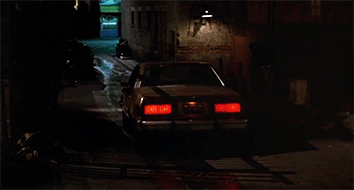
(This gif is mine).
This film has it all. A damn well cleverly written script with uncanny and hilarious dialogue, brilliant dynamic between the two main characters, fabulous music score, wonderful sets of shots (the cinematography of the beginning scene is great) and basically a simple story that is not only entertaining and easy to follow, but is acted out fabulously by everyone. The whole wild goose chase for these two men played by Robert De Niro and Charles Grodin across the country is just ridiculous, but ridiculously funny. I have to say that it’s definitely one of my top favourites of all time. If you want a laugh, I would recommend this one!
Special mention (another Martin Brest film): Beverly Hills Cop is on point also.
The Breakfast Club (1985)
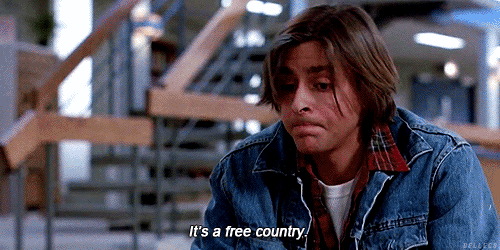
It was tough for me to just decide on one John Hughes film as he’s one of my favourite directors of all time, but I chose Breakfast Club because it’s the ultimate classic coming-of-age story, and it’s all set in just one location. It’s clever in that there doesn’t have to be lots of action to make it good, all it does is introduce a bunch of teenage stereotypes and take away the shields that they have put on and learn to no longer be prejudice of one another. Eighties is also my favourite era of films and this is just a perfect mixture of comedy and drama. The acting is great and I give applause to especially Judd Nelson and Anthony Michael-Hall for their delivery and their facial expressions.
Special mentions of other John Hughes films he has written/directed that I ADORE: Pretty in Pink (Andrew McCarthy and James Spader yum), Sixteen Candles (hilarious), Uncle Buck (the best family film ever), Planes, Trains and Automobiles and Some Kind of Wonderful <3
Heathers (1988)

Christian Slater and Winona Ryder are the best duo in this film and it is another eighties classic. I related to both these characters and I can never get enough of this film. I have probably seen it twenty times or more and still not fed up with watching it. The dark comedy and the gritty and foul dialogue are iconic in this flick, and I take my hat off to the brilliant Heathers (Kim Walker - may she RIP, Shannen Doherty, Lisanne Falk) for playing such clever and awful characters. I was obsessed at one point with Slater because of his role as J.D and honestly his death at the end of the film is a powerful as fuck ending. The cinematography of the ending makes the film for sure, the angle, the chosen shots I just Ugh. Fabulous.
The Help (2011)

This film. I don’t know it’s just brilliantly done and the acting is perfection. Emma Stone, Viola Davis, Octavia Spencer, Jessica Chastain and Dallas Bryce-Howard are fantastic in their roles and this film explores such a crucial time period that I think is illustrated well. These women while fictional, feel so real and the struggle of black maids (black people in general really but this is specific to the women) is real. I cannot help but cry everytime at the ending, and the way that Aibilene stands up for herself, I never get tired of. It is easy to watch as it’s not painful like 12 Years A Slave, but it still epitomises the segregation that was so prominent in the sixties in southern US very well. I find comfort in how delightful the characters are and still manages to be funny despite the story being focused on such a sensitive subject.
The Shawshank Redemption (1994)

Shawshank, well we all know this film. It has been parodied and quoted so many bloody times, but yet I am cliche in love with it and I cannot fault a single thing about it. Tim Robbins is an underrated as fuck actor and he should be appreciated so much more for his stellar performance as Andy Dufrense. He is the epitome of the straight and narrow man who, really, is not a bad guy at all. In fact, he’s always tried to be the opposite. You symphathise with him throughout and you really feel his struggle, but also his perfect ability to be so human. He makes Red realise he is not as bad as he made himself believe and of course we know how good Morgan Freeman is. Again, this film like Heathers I could watch a million times and never get bored with it. Whether it’s on TV or I find it available online, I always will make time to watch it.
Call Me By Your Name (2017)
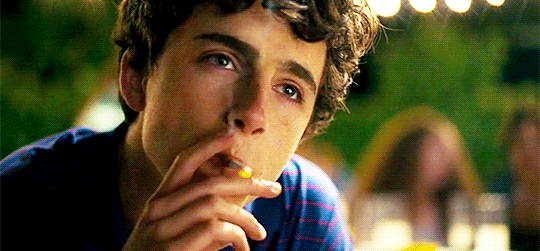
I have only recently come across this film about 8 months ago and it’s the kind of film which I can’t help but wonder where it’s been my whole life. I have already watched it probably like 10 times since I found it and I am so happy I did. However, it has led me to form an unhealthy obsession with Timothee Chalamet where he has come up in conversation in real life and I figured the only things I was still an avid fan of was of Supernatural and Red Dwarf, but no this film is just pure delightful dynamite. The cinematography is so elegant and perfect (especially during the dream like sequence when Elio is alone or in the gif above when Elio is watching Oliver). The screenplay brilliantly illustrates how wonderfully amazing but also torturous love can be, and well it is set in the eighties. What more can you love? Timmy and Armie have such good chemistry it’s unreal, and they make their characters so believable. Another film I cannot fault and could watch anytime, even though the ending is heartbreaking af.
Bonus: Bridget Jones’s Diary (2001)

Notting Hill (1999)

About TIme (2013)

There are plenty of other comfort films I adore but it probably depends on my mood. I’m definitely a sucker for romantic comedies and these three are on here as bonuses because they’ve also been very comforting to me over the years. What can I say? Richard Curtis writes some brilliant screenplays and directs some of them too.
#comfort films#comfort films challenge#heathers#good will hunting#the shawshank redemption#call me by your name#the breakfast club#the help#midnight run#notting hill#bridget jones's diary#about time#cinema lover
7 notes
·
View notes
Text
Solaire is the Sandworm and Other Apocrypha
What follows is an essay about Knight Solaire, a character from Dark Souls 1. The essay discusses his metatextual influence, his symbolic import, and a few theories about his supposed fate in Dark Souls 3.

On the Nature of Headcanon
Canon as a concept adopts different rules when it comes to videogames. More concretely than in other artforms, the content of the game changes according to its witness. You can’t account for another person’s playthrough, so you are obligated to trust their story—within reason. A player can tell you that they beat a boss without taking a single hit. That’s reasonable. A player can say that they saw an enemy clip through a wall, placing it in an otherwise empty environment. Could be true, might want to see footage, but reasonable. Further out, a player can tell you that a completely unprecedented game-object appeared out of nowhere, started flying around and corrupting objects. This is unlikely, but, like some crytptozoological encounter, could be explained away by the witness’ misapprehension (maybe a hacker invades the game and thwarts the rules).
Just like witnessing the mothman or other spectral phenomena in real life, the person’s impression of the event is real. To borrow Jung’s term, it is a subjective fact of the psyche. Because it is “of the psyche,” it describes the psyche.
Physical is not the only criterion of truth: there are also psychic truths which can neither be explained nor proved nor contested in any physical way. If, for instance, a general belief existed that the river Rhine had at one time flowed backwards from its mouth to its source, then this belief would in itself be a fact even though such an assertion, physically understood, would be deemed utterly incredible. Beliefs of this kind are psychic facts which cannot be contested and need no proof.
[…] The psyche is an autonomous factor, and religious statements are psychic confessions which in the last resort are based on unconscious, i.e., on transcendental processes.” (Jung, Carl pars. 553-555).
Unusual things will happen in games, and still more unusual things will be perceived to happen. What happens “off-screen” in the game world has no true authority, not even from the developers, because every player acts as a co-author. Some fan theories are formed by mentally structuring objects and events. Other fan theories seem to spring forth fully formed from the inky off-screen unconscious; in this case, for the theorist it feels more like a discovery than a construction. But most headcanons are a composite. Theories and headcanons are also informed by the meta-culture—by what a game and its characters have become in the eyes of “the community.” Black Iron Tarkus, for instance, has no lines of dialogue in any game, but has developed a personality and prestige from his interpretation by the fandom.
Such occurrences are almost a matter of course. Games, especially when they reach franchise-level popularity, spawn stories and memes. The game reveals content not programmed by its developers. It is doubtful that anyone at FromSoft foresaw Tarkus’ fandom. Nor would any on the staff have guessed that a few discrete game items (Giant’s Armor, Havel’s Ring, the Mask of the Father, etc) would cohere into a folk hero called Giant Dad. I say “folk hero,” though he is a scourge to many. This “character,” who is really just an exploitative blend of game mechanics, would be made, remade, imitated, elevated to memetic and then iconic status. Most other archetypes in Dark Souls are divided into their attributes: Helm of Artorias, Sword of Artorias, etc. Giant Dad is the reverse: he is constellated by his attributes; none of them alone hold his pneuma.
The Knight Solaire is more famous than either of these figures. Like Artorias, he is a character specifically designed to appeal and to exist in relation to; and yet like Giant Dad, he is a fan-fueled nexus of meme. Beyond both of these capacities is the degree to which he emanates himself beyond the franchise. His catchphrases “Praise the Sun!” and “jolly cooperation” have taken on a life outside of Dark Souls—a scope of renown unreached by Giant Dad. Especially noteworthy is his corresponding emoticon \[T]/ How many pop cultural icons can be summed up in 5 pieces of unicode? He has also been coagulated into an Amiibo, which is another ontologically ambiguous prestige, occupying a strange corner between meatspace, the virtual, and the symbolic apparatus of capitalism. But he is not quite so easily as commodified, as a Squid Kid or an Isabelle. He is not moe like they are. He does not have a face. But that is not say he is featureless: he has a personality and a mystique that coheres throughout his diegetic presence, his cross-cultural memetic tendrils, and his various costumes in headcanon. What force accounts for this coherence? No archetype can be summed up into a single definition or personality, but the style by which they draw attributes and myths around them allows us some understanding.

The Knight of the Sun
When encountered in Dark Souls 1, the character of Solaire presents a rare locus of optimism. He is standing in the sunlight, staring into the sky in quiet appreciation. He is immediately friendly and encouraging to the player, and gives them the tool of “jolly cooperation.”
I want to emphasize how much Solaire’s demeanor stands out in the milieu. Though he is encountered at an early point, the game has already introduced the player to an extremely dismal and unforgiving world. They have likely met many overpowering obstacles and dejected NPCs, and begun to realize how scarce is the refuge of the bonfire. It doesn’t take much exposure to Lordran to take on its infectious loneliness. Solaire’s optimism cuts through this bleak fog like a lighthouse, and he literally gives the player the key to online collaboration. From another gameplay standpoint, consider how the player has become conditioned to dark corners, to ambushes, and fatal surprises; to visually scouring the environment like a rat, wary of predators and keen to spot a glowing treasure. For a moment, Solaire stops the desperate scavenging to direct your attention to the skybox. These contemplative silences have become a signature of the Souls series, but this is perhaps the first directed instance.
This is to say that Solaire is the first personification of goodwill that the player meets, so early into their journey, and is thus easily wrapped up into that symbolism. As the player’s relationship to the world takes on new dimensions (not simply new game areas, but entirely new spheres: online play, community discourse, lorekeeping), the symbol of Solaire follows them. In online play, he pops up as someone’s cosplay—and spectacularly, most of these sunbros, these independent actors, will reflect his behavior accurately! In Souls communities, Solaire is almost omnipresent, as people will post his slogan or his emoticon as a way of communicating affirmation, respect, or pure joy.
There are other things to like about Solaire, like the fact that he is relatively powerful as an ally in boss fights, that he has the cool lightning move, or that it is revealed his armor is “average,” and that his strength comes from some inner source. Another element that should not be underestimated is the psychological potency of his implicit longing for a father. It goes without saying that the motif of the absent father has been especially compelling in the 21st century, ubiquitous in mass media, and often exploited by advertisers, etc. Beyond that, Solaire is searching “for his Sun,” an object which can be interpreted countless ways; suffice it to say it is a timeless and recognizable symbol of purpose and wholeness.
For all these reasons and more, Solaire is an easy point of projection for the player. He is an image both relatable and aspirational; he is average and exceptional. He is savvy, strong, and kind, and never in hyperbolic measure. He realistically represents a player’s best traits. The quality of his goodness is unspecific and broad; it becomes an anchor point for any virtue a player may value, as can be seen in the varied mutations he takes on in the subculture, becoming in turn funkier, wiser, more heroic. This trait of mutability, in itself, is generous! In a game that is by now famous for its therapeutic value in treating depression, Solaire’s influence should not be disregarded. Here is an illustrative example of the potential effect of Solaire on a player, posted to reddit by user unsuppressedYay:
Like most, when I was playing Dark Souls, I was in a very bad time of my life (which was incidentally only a couple months ago). I was at a college that I hated, with roommates who were not accepting of me, and many friends who had stopped hanging out with me. The only joy I would have is going home on the weekends, playing Dark Souls until I accomplished something and then going out to see my friends from back home. In this dark time i had isolated myself from most people during the week and was lonely and didn’t accomplished much, as such my grades also suffered. it was a bad time.
By playing dark souls, I felt accomplishment after getting through a particularly tough area or beating a boss. It gave me a reason to go on, that I would continue in the doomed world of lordran where i had to reach a fire with no good ending. It gave me encouragement to continue in my own life and applying to a different college and get my life back on track.
So to the point. I had accidentally spoiled what happened to Solaire. but I was still unable to stop it. I thought the chaos bugs were the big bugs in the lava after lost izalith. I felt so guilty and like I actually lost someone I cared about. I felt the obligation to wear his armor until the very end of the game. It made things significantly harder because of how weak it was compared to normal armor, but I stuck with it. The item description from the armor was something along the lines of saying that Solaire had no special power or magic, like we did. He made the armor himself, and was strong through his dedication and work ethic and never willing to give up to get his sun. So thanks Dark Souls and thanks Solaire for reminding me that optimism is the best way to go about things.
tl;dr cheesy story about dark souls helping me get through tough time, and feeling obligation to beat the game with solaires armor due to his wonderful optimism, and guilt over his death.
Even if a player doesn’t specifically don Solaire’s armor in tribute, they likely integrate some aspect of his character in other ways. It can be as simple as performing the Praise the Sun gesture before a boss or upon victory. Miraculously, the gesture conveys the attitude quite plainly. The phrase “what happened to Solaire” alludes to the tragic fate that befalls him if the player does not intervene: he goes hollow in Lost Izalith, loses his enthusiasm and direction, and apparently mistakes a Chaos Bug for the sun which he seeks. After this point he will be hostile to the player, and will be wearing the cursed thing upon his head. This piece of headgear, formed from the body of a chaos bug, emits a lighted orb resembling the sun. If the player follows an arcane route through the game, they can avoid this outcome, and bring Solaire as a helpful ally in the final fight against Lord Gwyn.

Solaire as Gwyn’s Son
For a long time, the battle at the immemorial kiln seemed like a fitting resolution to Solaire’s arc, as Gwyn was assumed to be his estranged father. Complementing Solaire’s recognition of an affinity between the Sun and the Father, we are told that Gwyn had a long-lost firstborn son. While essentially disproved by the apparent revelation of Gwyn’s actual first-born in Dark Souls 3, this lore speculation continues to live on in the imagination of the Souls community. It remains as another fact of the psyche, and thereby further illuminates the nature of Solaire. To understand why this is significant, we have to go a little bit into the symbolism of the Sun.
You may be surprised to hear that people have been aware of the Sun for a long time now, and it has accrued significations far too numerous to list in full. So we will just mention a few of its rays, those that coincide with Solaire’s virtues: generosity, joviality, light, warmth, and cooperation. It also symbolizes the gift of life, vitality, will, and essence. Then there is that important attribute: obviousness; there is simply no denying the Sun in the sky, as it illuminates everything around you, and your planet circles it incessantly. But this principle of “apparentness” follows the sun to its cultural correspondences, like the lion, who is known to be named Leo. Which chakra does the sun relate to? Why, the solar plexus. Guess which metal the Sun corresponds to. It’s gold. You don’t have to be an occultist or a psychologist to notice the sun’s dignitaries: they have a way of exuding themselves. So it is with the conspicuously named Knight Solaire and his undeniable presence. It is simply one of his attributes: the ability to beam out from the Souls world, through the metatext, and into broader strata of culture.
The solar principle is also a consciousness principle. To “shed light” upon something is to become conscious of it. Thus the Sun describes both the ego and the Self (the inner image of God). The ego can be thought of as a low-res isomorphism of the Self, or as an inner, inextinguishable “divine spark.” It seems that this spark is the source from which Solaire derives his boundless optimism. Solaire ambivalently identifies with the Sun, and marvels at it outside himself, terming it as a “magnificent father.” Though he is a source of light for the player, he humbles himself before the “gross incandescence” of some higher power. This ego-Self dynamic, so essential to human experience, triggers a (conscious or unconscious) question of reconciliation. So players may wonder, “Who is the father of Solaire? To whom does he defer?” and the natural affinities between Solaire and Gwyn present themselves.
Aside from the fact that it is later contradicted, this genealogy is also simply too concrete and anthropocentric to satisfy the greater mystery. The Solaire-Gwyn interpretation remains as a psychological fact, but it is just the beginning. It is the exoteric story, revealed to players of DS1 not as deception, but as an inaugural step for constellating a much more complex archetype. Now that we have taken a good look about how well the figure of Solaire invites a player’s projections, we will move on to a few other lore theories, far stranger and more infamous.
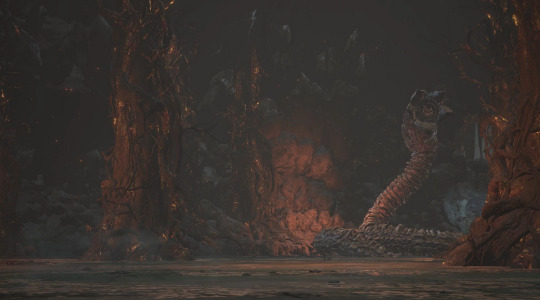
Solaire Has Become a Worm
Who was Knight Solaire and what became of him? Some say he is the great Carthus Sandworm, writhing around the Smoldering Lake in the ruins of Hell. While apparently originally suggested in earnest, the Sandworm story has come to be known as a meme theory. As we have discussed, a meme won’t exist if it’s not compelling on some level.
Here is the apocryphal myth as commonly understood. Canonically the player fails to save Solaire after he wanders into Lost Izalith in search of his Sun. He discovers the Chaos Bug (or slays it and discovers its corpse), and mistakes its gentle glow for his personal sun. Worn as headgear, it becomes the Sunlight Maggot, a “loathsome parasite” that is “completely immobile, yet still lives.” Solaire goes hollow, losing his identity and sense of purpose. He despairs. We don’t know whether the parasite produces this abject condition in Solaire, or whether it is symptomatic, or coincidental. Therefore speculation begins here. Assuming the player does not destroy the mad Solaire, he wanders around the underworld for a very long time. As the years go by the vast hellscape of what was once Izalith disintegrates. Its army of demons becomes hills of corpses. The land itself is now nothing more than a small maze of ruins, and a warm puddle—the so-called “Smouldering Lake.” During this time, the theory suggests, the parasite has completely consumed Solaire, turning him into the “Carthus Sandworm” an enormous, Dune-esque burrowing worm that spits lightning.
So because Solaire was overtaken by a Chaos Bug, it is assumed he never left Carthus and became the worm. The further justification(?) for this theory is as follows. The worm spits lightning as Solaire does. The worm drops Lightning Stake, a miracle that mentions lost dragon slayers, who are affiliated with Warriors of Sunlight and thus Solaire. The worm also has human appendages sticking out from its body, and drops an undead bone shard, which are seen as clues that the worm was once human. (It is also suggested by some that Solaire’s might and indefatigable nature are the reason that he was not consumed by the parasite, but instead transformed into an enormous creature. But this point is often glossed over in the meme-theory variant.)
We can see that the diegetic evidence upon which the case for Solaire-as-Worm rests is rather thin. So what accounts for its popularity? Why does it make some kind of intuitive sense? Why does it generate enough interest to be passed around, albeit ironically? Let’s examine the origin point of the story: Solaire venturing into Lost Izalith and losing his mind to a Chaos Bug. The story of a solar hero venturing into the underworld has—once again—existed for as long as people have been staring at the sun. Each day the Sun goes down, and comes up again reborn. Psychologically, the descent into the underworld symbolizes the journey of the ego into the unconscious. The principle risk of this journey is possession by the contents therein; re-absorption into a state of dependent unconsciousness. For this reason among others, it is associated with the great and destructive Mother in her negative aspect. The motifs of “the devouring mother” and the “belly of the whale” are likely familiar to most people. The loss of a sense of a separate self is a much-feared thing, and this story arises perennially and across cultures. Izalith too is full of (negative) Mother imagery, with the mother of pyromancy at the center, portrayed as a small bug, not dissimilar from the Sunlight Maggot which consumes Solaire. We should of course not reduce the Mother to some Freudian positivism. She is called the Mother because she represents the matrix of the world, which engenders, sustains, and decays all forms. In her fullness she is the divine feminine principle. Her fearsome aspects, such as the devouring mother, are constellated by the ego’s fears and rejections. The mother is the first being from which an infant must differentiate itself, and so there is this necessary period in which the mother becomes the abject, the locus of all that is disavowed and detested. When stories tell us about “slaying the dragon,” it is not about conquering the feminine, or defeating chaos; it is about overcoming a false view of the Divine Mother born of fear and prejudice. It is this view, cohered into a monster, that must be slain, as the Chosen Undead does in Izalith in Dark Souls 1. According to tradition, how is this accomplished? In psychological terms:
The slaying of the mother and identification with the father-god go together. If, through active incest, the hero penetrates into the dark, maternal, chthonic side, he can only do so by virtue of his kinship with “heaven,” his filiation to God. By hacking his way out of the darkness he is reborn as the hero in the image of God, but, at the same time as the son of […] the regenerative Good Mother. (Neumann 165)
The “father” in this case corresponds to the solar principles of Logos, order, and law. Swords and lightning-strikes, Solaire’s preferred tools, refer to the capacities of discernment and insight necessary for differentiation. This identification/alliance with the father in this task is only temporary, for the Father too must be destroyed: he is the old order, the ego deteriorating into an oppressive and petty tyrant. This is why Gwyn is underwhelming and ailing when we find him. So it appears that saving Solaire, and bringing him to defeat Gwyn, is a relatively psychologically healthy outcome. That is—if Solaire is the new ego!! But think about it: when playing a game, is it not the player-character who is most representative of the ego? It is out of the Chosen Undead’s eyes that we see, it is their actions we control, not Solaire’s. We have already established that for many players, Solaire is an ideal image, whose full potential is necessarily unknown. Does this mean that Solaire is meant to be abandoned here? Is he, like Gwyn, an outdated self-conception that must be discarded so that something new can be born? The moral judgment of this situation is more complicated than it first appears.
Let’s look at the steps one must take in order to save Solaire: one must join the Chaos Servant covenant and collect humanity for the “Fair Lady.” This witch of chaos is a pale and deteriorating spider-woman meshed into the wall of her lair. She speaks a language incomprehensible to the player, unless a special ring is worn, which reveals that she mistakes the player for her sister. If she is given a whopping 30 humanity, the Chosen Undead rises to a rank of prestige in her organization, and a special door opens which allows passage to the site of Solaire’s fall. This is the only way to arrive at the scene and destroy the bug before Solaire finds it. So the key, in essence, is offering your humanity to a mysterious dying witch over and over again. Or, as reddit user JotaBarra puts it:
To save Solaire of Astora you have to give 30 humanity to someone who you don't know, that doesn't understand you and the only thing you know is that she put herself in pain trying to fix something that she doesn't did. If you help her, the games give you the opportunity to save your friend. The only way to save Solaire is by being like him. Friendship is exactly like that. You help the only one that help you everytime he can. He will fight alongside with you against the final enemy. It represent what a relationship is. We don't build relationship with our direct actions but with what the actions mean. You dont help directly to your friend, but you do what he could've do for you.
This interpretation makes a good point about how it is necessary to become Solaire, to take on his attributes, in order to save him. Does this therefore mean that by the time the two of you get to Gwyn, you are the same person? Or were you the same person all along, and Solaire was just projected into the external environment, just as he both embodies the sun and seeks it outside himself? That light, whether the anglerfish lamp of the Sunlight Maggot or the Sun itself, compels the body forward, because that compulsion is the Sun.
Specifically, compulsion is the Sun in its chthonic state. It is synonymous with the ever-burning fuel of sulfur, replete throughout the realms of hell.
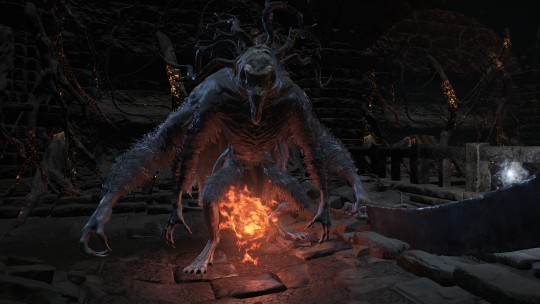
Lost Izalith, the Hell of Dark Souls, has been reduced to very little in Dark Souls 3. It appears quite plainly that the kingdom has deteriorated. What were once oceans of lava is now a knee-high lake of simmering water. However, among the ruins and heaps of demon corpses, there is indication that new life is growing. Roots of world trees coil around the stone and new forms of demons are singing living flames into being. Most significantly, there is also the presence of crabs, which are a timeless symbol of birth, and present at the other two places of world-regeneration in Dark Souls 3 (the forest and the painting). Beneath the desolate surface of Smouldering Lake, there is the beating heart of new life.
It is on the surface that the pseudo-Solaire worm confronts us. It could be that it is protective of this nest, or maybe it is a crude image of the unborn life in incubation within. The fact that it is coiled here, in a pool of water at the base of the world, suggests the kundalini serpent. In psychology and metaphysics, the kundalini is the libidinous upward force catalyzed by the primal energy (shakti) at the base of the spine. Alongside its physiological manifestation, the rising serpent/worm is one of the oldest mythological motifs:
The Gnostics related the serpent to the mysterious energy of the primordial waters symbolized in the waves of the undulating serpent as well as the stirrings within the serpentine spinal cord of man. The stirrings surface from the abyss of the unconscious, sometimes unexpectedly and with peremptory and terrible effects. (Valborg)
Its undulating path upwards is called “The Serpent’s Path” as it traces a parabolic shape as it climbs to ever-higher degrees of refinement (this is what the player does, you may recall). This journey of upward undulation, often felt by the individual as an electric current, is sometimes preceded by the “Lightning Flash,” the original impetus, which strikes downward from the crown to the lowest point, thus awakening the serpent, which makes its ascent. So these images come together quite conveniently in the figure of this lightning-spewing sandworm. You may remember that the worm drops “Lightning Stake”; not some other miracle, but the one that forces lightning down upon the earth. To see this electric serpent coiled up within a hot, subterranean chamber teeming with life—it is hard to imagine a more direct depiction of the kundalini.
We have talked about Solaire as a symbol of the Self, that was at one time appropriate but now needs to be refined, and it is therefore appropriate that he should find himself consumed in the flames of the underworld. The fiery hells of Buddhism are sites of purification; the fire that rages and torments the victim is their own unbridled affects, but they eventually exhaust themselves. What remains after is purified ash, synonymous with the “white foliated Earth” of the alchemists. It is this type of “environment” in which the “gold”—the personality—should be sown, in order to reach its potential. This is assumedly what has already happened to the Ashen One of Dark Souls 3, given their title and the fact that they have arisen from ash; it also seems to be descriptive of the process at hand for the kingdom of Lothric.
It’s easy to imagine that players might unconsciously project the image of Solaire’s rebirth onto this worm. For reasons related to Solaire’s story, as previously discussed, and for these perennial myths. At another point in the journey, the player is also confronted with Rosaria, the Mother of Rebirth, who “respecs” people—reallocates their stats and qualities. The only risk this refinement brings is that the person may become a worm! A few casualties of this process are seen or implied elsewhere in the game. These “mangrubs” are quite revolting, and yet at least a few are linked to the highest divinity. This should not surprise us:
Typical of the paradoxical imagery of the unconscious, the despicable worm can turn into the supreme value. Thus the messiah is equated with a worm in the messianic Psalm 22, verse 6: ‘But I am a worm and no man; a reproach of men, and despised of the people.’ (Edinger AoP 158)
For the full renewal of the image of the Self, it is necessary that the old king(/sun) dies. The body decays, and at its most revolting, it becomes the bed and the feast of maggots. Because Smouldering Lake is beneath the Catacombs, it can be said to be taking place within the body within the grave. The entire scene can be read as allegory of the processes within the body in the midst of its resurrection. The “messiah” here is invoked because Christ is another euphemism for the Self. And just as the dead king’s body is diffused into the bellies of the maggots, so too does Christ’s flesh become the object of consumption during the Eucharist. This takes us conveniently into our next bizarre fan theory.

Solaire Has Become Soup
Slightly more arcane than the theory of Solaire’s transfiguration into a worm, is the notion of his transubstantiation into the Estus Soup, which is found in a few cauldrons throughout Lothric. The justification for this theory was handily summarized on a reddit by a now-deleted user:
Consider the room you get the sunbro badge in undead settlement. It also contains an estus soup bowl...
The sunbro badge is found on a device for dismembering corpses. We know this becasue we see the same device being used to cut up bodies later in the undead settlement just before the stairs down to the lower area with the ravine
The sunbro badge is simply a rag of cloth sitting on the device, which heavily implies that a sunbro was cut up on this device and his badge was left over as a part of the cutting up process
Underneath the cutting up device are an absolute ton of small bowls, receptacles to contain fluid. What fluid will the cutting up device produce? blood and human bodily fluid.
These same bowls can be seen all around the main estus soup pot....
The blood of the dismembered sunbros/other undead is extracted in the cutting process into the small bowls. These bowls are then take to the main pot and their essences poured into the main soup pot which is boiled and the estus fluid is extracted from the blood of the chopped up sunbros. This is what forms the radiant estus soup.
The player is in some sense conditioned to think this, because the entire Undead Settlement is oriented around the disposal of corpses. Moreover, Estus Soup is found at two more places, one of which holds Solaire’s talisman, and the other near paintings of Gwynevere (saint of the sunbros). Now, the more reasonable interpretation of the presence of these Sunlight artifacts near Estus Soup is that Siegward, who is later shown to be the one concocting the soup, leaves them behind in his absent-mindedness. Siegward’s attitude and behavior are very reflective of the “jolly cooperation” ethos, and thus we naturally assume that he is affiliated with the Warriors of Sunlight.
This, however, does not disprove that the Estus Soup is Solaire! Not to say that Solaire was butchered by Siegward, and bled into the soup via the grisly method described above; rather it is more likely that a faithful Warrior of Sunlight has consecrated this special drink in a manner similar to the Christian Eucharist. To understand the concept of the Eucharist, here is an excerpt from the Gnostic Gospel of Thomas:
The cup of prayer contains wine and contains water, being established as a representation of the blood over which thanksgiving is offered. And it is full of the holy spirit, and belongs entirely to the perfect human being. Whenever we drink it we take unto ourselves the perfect human being. The living water is a body.” (Gnostic scriptures p347)
In other words, “the Eucharistic blood represented the Soul of Christ.” (Jung & von Franz 93). The fact that “the conception of blood as soul prevailed in the middle ages,”(ibid. 93) is visually quoted by Dark Souls periodically, and further prepares the player to respond to such symbolic signaling within this fantasy setting.

Now, Solaire as a Christ figure who becomes the subject of a Lothric Eucharist is probably not a theory that anyone would thread together without the specific intent of performing a Christian reading of Dark Souls. The reason that I discuss it now is because the existence of the Solaire-as-soup theory seems to have arrived at a similar situation unconsciously, and slightly rephrased into a secular materialist framework (more palatable to the conscious mind). We have examined how Solaire is an uncommonly strong draw for projections of the player’s better nature. It is also a fact of our world that certain Christian concepts—such as Christ representing a fully realized being to whom we should aspire, or the mysteries of the Eucharist—are present in the background of the unconscious. These stories and motifs were so ubiquitous for so long in the western world, that even if we live fully secular lives, this material continues to radiate its influence through the thinnest, unassuming little cracks in our speech, our aesthetics, and our stories.
So without any intention on the part of the player, their experience of the character Solaire receives some influence from the Christian world. This effect is aided by a few other elements. There is his resemblance to common depictions of knights from the Crusades, whose defining associations are Christianity and the fact that they were seeking something. Of course we also have the fact of his signature gesture which is similar to the pose of the crucified Christ. This essay has already described this gesture’s prominent contribution to the memetic potency of Solaire, but it bears mentioning that if the player joins this covenant, they perform the gesture automatically upon being summoned—any active sunbro is quite literally forced into imitating this pose! And of course, a third reason for this unconscious association of Christ and Solaire is the factor of the mysterious and divine parentage.

Which is Canon?
So of these two fringe headcanons, which is the more valid? Is Solaire a worm or is he soup? Taking anthropology into account, we must recognize that the death and resurrection of the Sun-god naturally predates Christ, and Christian myths are often studied in that context. It is just as natural to see Solaire as a personification of the Sun, of goodwill, or of the Logos … although Christ also covers that ground. Whatever the case may be, the dismemberment and consumption of this embodied principle seems to be a common feature of these stories. Both the worms who feed on the king’s corpse, and the Eucharistic wine/blood, are images of this concept—and perhaps both images are necessary. The feast of the worms is the profane image, and the Eucharist is the sacred and civil version. After all, for the dissemination of this quality of consciousness to be complete, it must extend to every level. Edinger gives us another broad summary of the concept:
[The Golden Man] represents the microcosmos or monas, the initial matter, which also contains the goal of the work. His dismemberment signifies a new conscious ordering of his initial chaotic nature.
It is difficult to consider terms like “initial matter” and appreciate the fullness of the concept. In nitpicking over the details of the specific images, we may begin to lose sight of the importance and universality of the basic story. This is why it is so important that there are multiple histories, multiple headcanons. If Solaire was only the worm, or only the soup, he would be less complete and less adequate as a symbol. And there are many headcanons besides these, of course; they merely represent two aggregations with a mythologically fertile tension between them. By the incredible multivalence of the Sun’s many arms, he means something different and individual to each player.
And speaking of the “goal of the work.” The return of the Sun in the morning is not considered a triumph merely because it has survived. Withstanding the night in itself is hardly an achievement! It is a triumph because something has been earned in the descent, and the same is true of the story of Christ’s incarnation. When the Sun-god rises again, something has been purified, refined, or to use the preferred Christian term, redeemed. The personal stories of players also seem to follow this trajectory. Dark Souls doesn’t treat depression simply because players are enduring its difficulty, it’s because some special quality of attention is polished through their struggles. We ought also to remember that Solaire willingly became Undead so he could visit Lordran and find his own Sun. The descent into incarnation for the purpose of refinement is a journey that should only be made consciously, with optimism and good cheer, for that is the Sun’s native condition.

Edinger, Edward. Anatomy of the Psyche. Open Court Publishing Company,
1985.
Jung, Carl. Psychology and Religion: East and West. Princeton University Press,
1969.
Jung, Emma & Marie-Louise von Franz. The Grail Legend. Sigo Press, 1980.
Layton, Bentley, ed. The Gnostic Scriptures. Yale University Press, 1995
Neumann, Eric. The Origins and History of Consciousness. Bollingen
Foundation, 1954.
Valborg, Helen. Great Symbols Series: the Serpent. Theosophy Trust, 2013.

Solaire is Pump-a-Rum
Actually, you are this fledgling.
#dark souls#dark souls lore#solaire#knight solaire#dark souls 1#dark souls 3#solaire sandworm#carthus sandworm#gwyn's firstborn
82 notes
·
View notes
Text

[This is not the official icon and banner as those are still in work]
Technical side:
1. It's going to be a novel game programmed with the help of Ren'Py.
2. The illustrations will exclude MC in order to let every player imagine whoever they want as them.
3. The game will be written in first person POV and present tense.
About the game's universe:
The game takes place in an alternate universe where Lotor was born to Zarkon and Honerva who are both alive and not changed by the quintessence overdose, the rift was closed without reaching the point when there was a need to destroy Daibazaal and therefore no war has occurred. Moreover, the timeline is altered so that Altea, Earth and Daibazaal all are inhabited by intelligent species at the same time and are working to find harmony in living together. Voltron exists but will play no role in the game itself. This game is supposed to be paceful and focusing on the romance mostly.
The MC is an Altean ambassador sent to Daibazaal to mingle and be kind of a link between the Galra and Alteans if need be, but they are supposed to just spend time on the planet and learn about the Galra race. Therefore (once again) the game will have that slice of life vibe to it mixed with eventually a little of action and of course, romance.
The dateable characters will be: Acxa, Ezor, Lotor, Narti and Zethrid. But, if need comes, there may be added a secret bonus route ;)
What I need help with:
1. Art:
- Backgrounds
- Illustrations
- Character sprites
- Concept art for the clothing
- In game icons & menu graphics
Edit: We are looking mostly for digital artists. The backgrounds can be done traditionally (or contours for illustrations/sprites with ink) but other than that traditional art usually simply doesn't fit in a game.
2. Writers:
- Help with finishing the initial script
- Dialogues
- Narration
3. Sound effects:
- Music
- Additional sound effects
Will there be any payments?
No. The game is made by fans and for fans. I do not intend on earning money from it so it's only fair I don't have to pay any of you - especially since I'm an already struggling student that could as well just go get a job instead of making a game for other people's enjoyment.
How to apply?
That said, I would like to ask you to submit your application to my business email. It’ll be more neat and i won’t miss your application this way (but you can DM me on here as well to make sure I got your email or to ask stuff about the game itself. I’ll do my best to respond accordingly):
Please write what you'd like to contribute, include examples of your work (more below), write down your discord code and add why you got interested in the idea. There is no stupid reason, honestly, I'm just curious if you're as gay as I am for the generals or just like to work in a team on things like those or maybe just thought it's fun. I promise I'm not going to be an ass to you and neither will be the people who already are in the team. We're all big fans of Voltron and just want to have fun by creating something together :>
You can send your applications till September 16th. I’ll take a moment with replying to the mails though, because I have to prepare myself for the exams I have at the end of that week so please be patient. I’ll reply to every each of them eventually.
For writers: Just take in consideration that (once again) I want to know how you see the characters from your own perspective so please give examples like those or show me how your narration looks (for different descriptions that are to come). A view on the generals will be greatly appreciated (I know everyone loves Lotor but he’s not going to be the only LI here ;P)
From artists: I want the example of your work to be neat as in not messy sketches but actually finished pieces. Also if you are aiming for drawing the sprites/illustrations I want it to be more anatomically correct than not - you are allowed to use a base if you want to apply but have this problem as long as it’s free to use. I can help you with anatomy afterwards. Your art doesn’t need to be voltron-connected for this! - I just want to see how you go about it in general.
Seriously, you won't know if you're "good enough" (how some may say it) unless you actually try :>
And PLEASE SHARE THIS POST so that more people actually have a chance to try.
#vld#vld acxa#vld ezor#prince lotor#narti#zethrid#lotors generals#voltron legendary defender#ambassador game#yes this is going to be the name of the game (Ambassador)#and it's the tag I'm going to use for it from now on#once again posting to this blog first because it has more followers#please share
122 notes
·
View notes
Text
The 5 Most Disappointing Sequels (& 5 Most Underrated) Of All Time
There’s no doubt that we’re living in a heydey for sequels. The only trouble is in sorting the good from the bad. Sometimes, a sequel can be built up to perfectly over time only for the final product to feel like it had no effort put into it at all. Other times, sequels can come and go so quickly in the life of a franchise that greatness passes by unnoticed.
Here are five sequels that failed to live up to the expectations set by their outstanding predecessors and five that deserve more appreciation than they’ve received from critics and the public at large.
10 Disappointing - Jack Reacher: Never Go Back
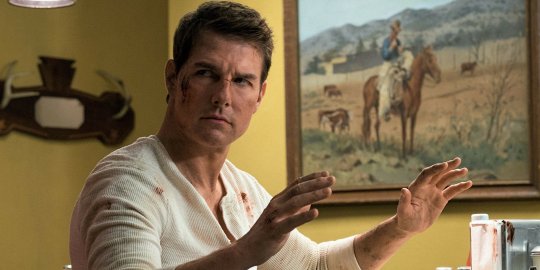
Christopher McQuarrie has been one of Tom Cruise’s most significant creative collaborators from the past decade and the two of them found an understated kind of magic when McQuarrie stepped into the role of director on Jack Reacher.
RELATED: Tom Cruise’s 10 Most Memorable Characters
The two would go on to parlay that chemistry into Cruise’s flagship franchise, the Mission: Impossible series, to great success. But it left the Jack Reacher franchise in need of a new director and Edward Zwick’s follow up, Never Go Back, contains none of the things that charmed about the original. The score, cinematography, choreography and overall style of storytelling are noticeably altered, and none of them for the better.
9 Underrated - A Nightmare On Elm Street 2: Freddy's Revenge

The first sequel to Wes Craven’s smash hit 1984 horror movie A Nightmare on Elm Street is one of its strangest, and that really is saying something. Initially panned by critics and considered the black sheep of the franchise by fans, Freddy’s Revenge has only grown in notoriety and popularity over the decades because of its glaringly apparent homoeroticism.
It’s a subject that’s caused controversy that exists to this day, centering around lead actor Mark Patton’s feelings of being outed by the movie, with writer David Chaskin only admitting to the blatantly overt themes in the screenplay relatively recently. Patton has since produced a documentary titled Scream, Queen! My Nightmare on Elm Street which illustrates his experience with the movie and homophobia in Hollywood at that time.
8 Disappointing - U.S. Marshals

Tommy Lee Jones’ performance in The Fugitive not only earned him his much-deserved Oscar, it produced one of the most famous pieces of of improvised dialogue in the history of cinema. With seven other Oscar nominations for the movie, it was no surprise that a sequel centering on Jones’ secondary character got greenlit.
RELATED: 10 Best Robert Downey Jr. Roles According To Rotten Tomatoes
U.S. Marshals was – and still, very much, is – a black hole a of a movie. Sheer, crushing, nothingness. You can’t even really hate it because, to hate it, you’d first need to remember it. A quality made all the more baffling by the fact that Jones was joined by immensely charismatic supporting actors Robert Downey Jr. and Wesley Snipes.
7 Underrated - Beneath The Planet Of The Apes

The first sequel to the infamous adaptation of Pierre Boulle’s original novel, Planet of the Apes, was a success on release, spawning a series of sequels and reboots lasting right up until today. But it remains one of the most poorly reviewed of the Apes movies despite being one of the best.
Beneath the Planet of the Apes is daringly bleak in its outlook, even topping the original’s ending in terms of abrupt shock value. Few stories that are designed to make money for more sequels have the kind of guts to end all life on Earth and leave the audience walking out in total silence as the credits roll.
6 Disappointing - Ocean’s Twelve

Steven Soderbergh’s remake of the Rat Pack classic was an intoxicating serenade to stardom itself. Its lightning-in-a-bottle brilliance was unlikely to have been recaptured by anyone and, while they do seem consciously aware of that fact, the sequels inescapably feel like a waste of the talent involved.
RELATED: 21 Wild Details Behind The Making Of The Ocean's Movies
While Ocean’s Eleven felt like it was pulling off an impossible trick, its true power came from a masterful balancing of tone between thoughtful melancholy and comedic hijinks. Ocean’s Twelve got all of Ocean’s Eleven’s brainy qualities but none of its fun ones, and Ocean’s Thirteen vice versa.
5 Underrated - RoboCop 2

After taking over from George Lucas on Empire Strikes Back and securing Star Wars as one of cinema’s most significant franchises, Irvin Kershner only directed two more movies. Never Say Never Again, which brought Sean Connery back to the role of James Bond for one last time after two retirements and, finally, the sequel to Paul Verhoeven’s iconic 80s sci-fi splatterfest RoboCop.
RoboCop 2 was considerably less loved when it came out but its memory has remained as vivid, particularly as it’s one of the science-fiction movies of that era that made an accurate prediction of the future. Unfortunately that prediction was the bankruptcy of the city of Detroit but it does highlight the movie’s achievements in social satire. Kershner generally amplified what was most enjoyable about RoboCop, especially the work of visual effects guru Phil Tippet.
4 Disappointing - The Ring Two

Gore Verbinski’s remake of Hideo Nakata’s seminal horror movie was worthy of the original in every way. It was so successful, unfortunately, that it’s largely thought of as the catalyst for Hollywood’s subsequently careless pillaging of Asian horror movies for remakes over the following years. It was, however, Nakata himself who ruined the American version of the series with the monumentally inferior sequel.
RELATED: The 13 Most Underrated Horror Sequels Of All Time
Interestingly enough, just after shooting began, The Ring Two’s production offices had to be cleared out after they were seriously flooded in, what the assistant production coordinator described as, “something out of a horror movie, for lack of a better term.” The eerie connection between water and evil in the movies wasn’t lost on the cast and crew but, unfortunately, nobody took the hint.
3 Underrated - Predators

A few years after breaking into Hollywood with his $7000 indie debut El Mariachi, Robert Rodriguez was working on his first studio movie for 20th Century Fox and submitted a treatment to them for a Predator sequel. It was dismissed and buried in a pile somewhere for fifteen years until it was unearthed and finally greenlit.
With a flawless cast and a creative drive from a much more emboldened Rodriguez – now with his own studio to produce the movie how he wanted it – Nimród Antal’s sequel delivered the most devout recreation of the original Predator’s sense of fun so far. Naturally, everything that worked about it was abandoned for a far more unsuccessful reboot made under stricter studio control. That’s show business for you.
2 Disappointing - Book Of Shadows: Blair Witch 2
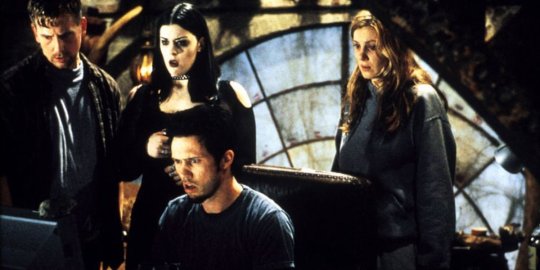
The sequel to the game-changing found footage horror movie The Blair Witch Project was a rushed affair, as sequels to surprisingly successful low budget horror movies often are. The sequel debuted in cinemas a grand total of fifteen months after the original and dumped both its narrative universe and its defining found footage style.
RELATED: 15 Worst Horror Movies Of All Time
Whilst it’s true that Book of Shadows isn’t as bad as its reputation suggests it definitely isn’t that good either. Most reappraisals focus on what the social commentary of the movie was intended to be before studio mandated last-minute reshoots and editing changed it. But there’s no real evidence that the original vision would have been much better.
1 Underrated - The Color Of Money
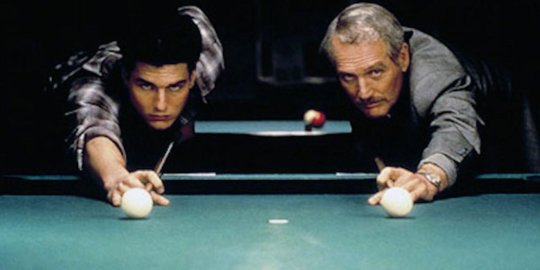
Released twenty-five years after the original, Martin Scorsese’s continuation of Robert Rossen’s towering 1960s pool drama The Hustler stands as one of the most underappreciated Scorsese movies, sports movies, and sequels of all time.
The movie certainly has appreciation, it won returning star Paul Newman an Oscar for Best Actor. It wasn’t without its detractors, however. It generally did well critically but it received Scorsese’s only Two Thumbs Down ever from Siskel and Ebert. Ebert being one of many who speculated that Newman only won the Oscar as a show of respect for The Hustler but Newman already had an honorary Oscar for acting from just the previous year.
Legacy aside, The Color of Money is one of Scorsese’s boldest and most experimentative movies. It respects the original absolutely but never lives in fear of it, creating a timely update of The Hustler’s examination of American dramatic character.
NEXT: 25 Best Movie Sequels Ever Made
source https://screenrant.com/movie-sequels-disappointing-underrated/
0 notes
Quote
THIS
REVIEW MAY CONTAIN SPOILERS
Ultraman, a SciFi series that started in 1966,
based on the character from Ultra-Q, a Japanese twilight zone style show, gets
a Netflix Original anime based on the manga by Eiichi Shimizu which is a sequel to the
original TV series. Produced by
Production I.G it shares some visual similarities to Netflix’s other 3DCG anime
Ajin: Demi-Human made by Polygon pictures.
The Story
The story follows a young Shinjiro Hayata
a second year in high school and the son of Shin Hayata the current Minister of
Defense and retired Ultraman of days past. Shin has lost his memories of being
Earth’s giant warrior after the threat of invading aliens has come to its
conclusion. Earth, now enjoying a period of peace, lacks a defender as slowly
but surely unrest and uncertainty congeals in the secret alien settlements of
earth. The SSSP, that is the Science Special Search Party, still operates in
secret and deals with an alien that breaks the law and has been “marked for
elimination”, a la Men in Black. It’s newest member is our protagonist Shinjiro
as he dawns the new Ultraman suit to protect the earth from evil aliens and saving
people from dangerous situations. It is also worth mentioning that the anime
deviates from the original as it is no longer a fight between men in rubber suits
fighting in model cities, causing massive collateral damage and death wherever
they fight, but rather becoming Japanese ironman in regular human size, thus
making the public believe the hero is but a simple cosplayer in the first act.
The story is grittier and more rooted in reality than the original as it
explores its themes of responsibility, power and the ability to wield it,
ethical murder, and terrorism.
As we follow our protagonist coming to terms
with murdering evil aliens, the responsibilities of dawning a hero’s mantle and
being able to use his abilities properly, his character becomes more heroic and
far less reminiscent of a whiny Shinji Ikari. A bit more time could have been
used to develop the relationships between Shinjiro and his father, as he barely
gets any screen time as it is and feels like a praise dispenser in the first
place, as well as the complicated relationship between Shinjiro and Dan
Moroboshi who dawns the mantle of Ultraman Seven. The story moves quite quickly
yet never feels rushed due to its extensive use of quieter and slower parts
that gives a bit of breathing room to its action-packed fighting sequences.
Another caveat of the show is that it spends quite a bit of time on world building
which is quite welcome to viewers who never even heard of the original series,
and like me, certainly weren’t around at the time to enjoy it. Yet it also has
quite a few glaring flaws. The whole season has a few distinct conflicts and
set pieces, yet by the time the final one rolls around one are left asking
oneself “Wait, what was that all about?
That was a bit sudden.”. In fact, the finale was marred by sloppy writing as it desperately attempts to connect plot
threads from the beginning of the season yet it came across as completely
forced and an excuse to indulge in some much-needed character development and
show off how awesome our heroes are. As far as character flaws go, and I don’t
mean the kind that is the hallmark of good writing, Shinjiro seems really
incompetent about keeping his identity secret, not out of malice or self-destructive habit, but simply because he can’t keep his mouth shut in front of
a girl. Its as if he never grasped the concept of “think before you act”.
Another glaring writing flaw is highlighted by the fact that Shinjiro has
trouble controlling his inborn superhuman strength despite living with it for
16 years. One would think that at least by then one would have mastery over
their own body. Furthermore, part of his character development is that he was
initially in it for the glory of being a superhero without all of the strings
that come attached with that, spawning a subpar plot of “will he or won’t he
ever take up the mantle”. In fact, Shinjiro as a character is barely believable
as it stands. On one hand, he seems to barely be able to rub two brain cells
together and on the other he is somehow a hand to hand combat master, holding
his own against powerful foes. No explanation is given as to why that is the
case by the way. Most of the supporting cast is either a walking talking
conflict generator or they react to what is happening on screen in a desperate
attempt to convey the emotions the audience is supposed to feel. Dan Moroboshi
is one of the few characters that break the mold. He despises Shinjiro for his
lack of experience yet acknowledges his outstanding talent that makes up for
it, making him a lot more interesting and complex than the protagonist. His
motivations are far more clear and righteous, even if he won’t hesitate to take
out “alien scum”. In fact, I subconsciously only started to tolerate the
protagonist when Dan did.
The Audio
The sound design in Ultraman is quite the
treat. Sound effects are good and convincing allowing one to immerse themselves
in the show and the soundtrack is great. All the audio is in very high quality,
clear, well mastered and not grating or annoying. As a “man of culture” aka. “A
massive weeb” aka “dumpster fire connoisseur” I prefer the original voice
acting for anime and read the subtitles like a hipster film student watching French
movies in an attempt to look more sophisticated for his social circle.
Therefore it is not exactly an easy task to judge the voice acting as I don’t
speak Japanese. However from what I can discern it seems at least on par with
most shows out there. All in all, there isn’t much more to say, the soundtrack
has an excellent heroic main theme, the battle theme has some great electric
guitar, and quieter scenes get some nice strings and piano treatment. To
summarize, “it sounds good bro.”
The Animation
Its visual style has become a point of
confusion for me. The character models all have enough depth and detail to make
the characters believable when they aren’t attempting to emote that is. 3DCG
does not work well when it comes to detailed animation. Facial expressions look
stiff, blank, and awkward most of the time. It certainly helps that the most
important characters emote with a mask on. Furthermore, the animation is wildly
inconsistent resulting in some hilarious eye cancer at times. More on that
later. The lighting is fine if not good in some scenes but the environments
suffer from the typical low-resolution texture work used for backgrounds.
Crowds and background character models are straight from bad CG hell. This is
not the only time something appears low quality or cheap though. A severed arm
and head that looked like it came straight from the PS2 era, odd character
movements, Video Copilot Action Essentials blood spatters and more. My biggest
gripe, however, is with the frame rate and animation quality. It is quite well
established that 2D anime will typically be produced at a lower frame rate in
general even half of what one would normally use in filmmaking and even less
for background characters yet this does not translate well to 3DCG. Like, at
all. A lot of motions look choppy and unappealing while at times it will be
smooth as butter. Its as if you are playing a game and your system from 1999 is
melting as it attempts to render cutscenes in real time. The worst part about
this is that the choreography is really excellent in its hand to hand combat
scenes. A lot of work was put into them and it shows. Clearly, this was a
stylistic choice and not a technological limitation, one I am no fan of.
Another issue pops up occasionally due to this choice as sometimes it is nearly
impossible to judge how fast something is happening. Most of the time when slow
motion is used it is very clear and deliberate, yet I remember one very
distinct scene where I for the life of me could not tell whether it was
supposed to be in slow motion or real time. But the worst animation seems to be
during the shows quieter dialogue moments. There are very few words that can
describe this particular brand of motion vomit but the best word I have for it
is jarring. This seems to be a fairly common trait when it comes to 3DCG anime,
however, this unsettling style can be used to one's advantage and doesn’t always
have to be a detriment. Ajin: Demi-Human is an excellent example of this. The
jarring animation and cel-shaded character models helped solidify the creepy
undertones of the story and especially the unsettling nature of the “Ghosts”.
The animation serves to illustrate the story and the style subtly adds to its
atmosphere. If you haven’t seen Ajin yet, it is certainly worth your time. Give
it a try.
The
Conclusion
In conclusion, Ultraman is certainly
watchable. It has enough action scenes where you can simply turn your brain off
and enjoy the spectacle. That is if you can stomach some of the choppy
animations. Set pieces are for the most part quite awesome without getting too
ridiculous, bar one exception in the finale, and the story will keep you
engaged long enough even if it is not something to write home about. So if you
have nothing to watch, give Ultraman a try, it's not great but not terrible
enough to never touch with a 10ft pole.
What did you think? Let us know in the
comments below. Don’t forget to like and subscribe for more anime content and
hit the bell icon to always stay up to date.
http://www.amerimewire.com/2019/06/ultraman-review-by-james-halmer.html
0 notes